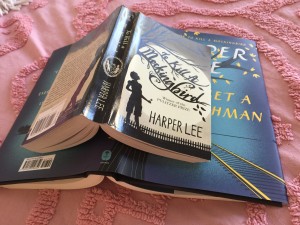
Small-town Alabama, in the Great Depression (TKAM) or in the fifties (GSAW), was racist. It’s still quite racist, from what I hear and read. (I’ll be traveling there in October and will give a first-hand account of my experience then.) But so are lots of places in the USA. Racism is still prevalent, pretty much everywhere. I grew up in super liberal Marin County and I learned racist slurs and rhymes. Racism is everywhere. To express shock that the fictional character in a book written about either of those time periods — but especially in the thirties — wasn’t racist seems naive.
Since I don’t have the baggage of having read TKAM a dozen times (or even once) since my adolescence, I certainly don’t have the same attachment to envisioning and sanctifying Atticus Finch in one particular way. But I can relate, to an extent. A set of books I grew up on, The Little House books, has a character, Pa (Charles), based on the author’s real father, who is also just, true and faithful. Always loving to his daughters, always dreaming of a better life. What would I say if Pa had been exposed later as a racist or a man with feet of clay? Would that show me the angst people are feeling now over the loss of their dream-daddy, Atticus? It might.
But that event, in fact, has happened. I have read everything I could find about Laura Ingalls Wilder precisely because I am such a fangirl, and some of that reading has been distinctly eye-opening. Pa was a fly-by-night poet and a dreamer who “married up” to Ma’s social class, and she (a shameless racist herself) had to fight to keep them in one place long enough to get an education for her daughters. Laura’s loving glances at her father, and his returned gaze, have been interpreted as incestuous by some critics. And the family stories themselves were doctored by Laura’s probably bipolar daughter Rose, a staunch Libertarian (and cofounder of the political movement) who urged Laura to fudge the facts to make a better story.
How did I feel about that? Chagrined, of course, but also not surprised. Stories are stories, and facts are facts. I don’t think it’s possible for this white family in TKAM to have lived in small-town Alabama in the 1930s with a Negro housekeeper and a segregationist society and not be affected. Aunt Alexandra was affected. Uncle Jack, Atticus, not so much. The kids saw color. They didn’t understand the background so much, but they knew there were issues.
In TKAM, Scout and Jem attend church with Calpurnia and are confronted by a black church member who doesn’t want them to attend. At that moment, the children understand fully what it’s like to be excluded on the basis of race. The rest of the church allowing the two white children (of a prominent citizen) to come in and feel welcome shows less openness and more — well, maybe self-preservation. Just as Tom Robinson was doomed from the moment Mayella Ewell saw him passing by and asked him to come chop her firewood or whatever else she wanted — the church couldn’t refuse hospitality to Calpurnia’s employer’s children. Tom couldn’t say no and live; the church membership, despite all appearances of merely being hospitable, also couldn’t say no. That’s how ingrained the racism was.
It seems clear that Atticus is a man of character. He sees injustice in Mayella’s (or her father’s) accusation against Tom. He hates an unfair fight (which is why he stopped using guns as a youth, when it was clear he would kill anything he aimed to shoot). And Atticus is a man of duty — he was assigned the case; he didn’t seek it out. He saw through to the end, as far as he humanly could, that the case got his best work. He is a solid man of his word, and he remains that way through both narratives. In other words, Atticus doesn’t change substantively in TKAM, any more than he has “changed” in GSAW. And the mark of a central character is that he or she changes. The arc of growth is the story. Atticus himself is static in TKAM — and he’s still the same, only older, in GSAW.
So the focus of both stories is Scout — what she sees and knows. She grows up by three years in TKAM and learns that people are multifaceted and not always trustworthy. Her experience of getting to know Boo Radley, of working for the hated Mrs. Dubose, and of seeing Calpurnia in the world (Scout’s house) and at home (Calpurnia’s church) taught her that there is more to most people than meets the eye — a worthy lesson: Don’t judge. Scout, as the adult Jean Louise, has also learned about people, having broadened her horizons in New York City. Coming home, she sees at last how small-minded her neighbors are, her Aunt Alexandra, and even her father. She has changed — and again has to grow and change to accept people (even her social inferior, her fiance Hank) for who they are.
Either way, these are Scout’s stories. This is her arc. Although Harper Lee wrote GSAW first, and her editor set her to rewrite, bringing us TKAM, I don’t think it’s the lesser story. I’m perfectly comfortable with GSAW as a sequel — or even a prequel — for TKAM. I believe they are both necessary and valid, now that they are both out in the world.
I wonder if I could have concluded thusly had I read TKAM first?
Your thoughts?
